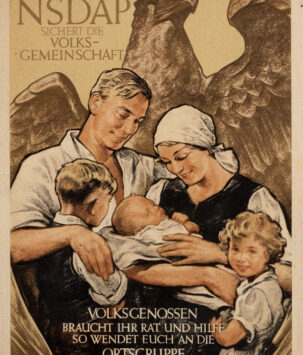Felderrnhalle Mahnmal Bronze
The Mahnmal der Bewegung was a memorial designed by Paul Ludwig Troost, Hitler’s foremost architect, whose neoclassical style served as the official architecture of the Third Reich. This one-of-a-kind, 1:10 scale bronze was manufactured by Jeweler Biwus & Burkhard of Augsburg, commissioned as a gift to Ludwig Schroff for his 50th birthday. The Schroff family were printers from Augsburg who were responsible for printing various propaganda posters including Hitler’s campaign poster Nur Hitler and The NSDAP Secures the Volksgemeinschaft.
The monument celebrates sacrifice, bravery, martyrdom and duty, central tenets of the National Socialist ethos. The monument stood in the Feldherrnhalle (Field Marshals’ Hall) in Munich, site of the Beer Hall Putsch of November 9th, 1923, later consecrated as a tomb for the martyrs of National Socialism. Inspired by Mussolini’s March on Rome, the Munich Beer Hall Putsch was an early attempt by the National Socialists to overthrow the Weimar Republic which was widely viewed as decadent, ineffective and corrupt. The failed coup saw the deaths of 16 partaking party members whose martyrdom was sanctified as part of the National Socialist mythos. The 9th of November became a national holiday and one of the most important dates on the German calendar.
The face of the monument (translated to English) reads: On the 9th of November 1923, the following men fell in front of the Field Marshalls’ Hall and in the courtyard of the Ministry of War, faithfully believing in the resurrection of their people, followed by the names of the 16 insurrectionists who gave their lives on that fateful day. The obverse reads Und ihr habt doch gesiegt! (And yet you triumphed!), celebrating the triumph of National Socialism through the sacrifice of its adherents. The event gave credence to the belief that selfless acts of individual heroism in service of a greater purpose are neither in vain nor go unnoticed – a universal dogma that served as an evolutionary cornerstone of human cooperation. The monument naturally held great significance in Nazi Germany, being under perpetual ceremonial guard by the Schutzstaffel (SS) and used for parades and commemorative rallies alike. New SS recruits were known to take their oaths of loyalty to Hitler in front of the memorial in the hopes that they would fulfill their duties with the same spirit of sacrifice and selfless loyalty to ones community as embodied by these 16 martyrs.
Free shipping on orders over $50!
- Satisfaction Guaranteed
- No Hassle Refunds
- Secure Payments
The Mahnmal der Bewegung was a memorial designed by Paul Ludwig Troost, Hitler’s foremost architect, whose neoclassical style served as the official architecture of the Third Reich. This one-of-a-kind, 1:10 scale bronze was manufactured by Jeweler Biwus & Burkhard of Augsburg, commissioned as a gift to Ludwig Schroff for his 50th birthday. The Schroff family were printers from Augsburg who were responsible for printing various propaganda posters including Hitler’s campaign poster Nur Hitler and The NSDAP Secures the Volksgemeinschaft.
The monument celebrates sacrifice, bravery, martyrdom and duty, central tenets of the National Socialist ethos. The monument stood in the Feldherrnhalle (Field Marshals’ Hall) in Munich, site of the Beer Hall Putsch of November 9th, 1923, later consecrated as a tomb for the martyrs of National Socialism. Inspired by Mussolini’s March on Rome, the Munich Beer Hall Putsch was an early attempt by the National Socialists to overthrow the Weimar Republic which was widely viewed as decadent, ineffective and corrupt. The failed coup saw the deaths of 16 partaking party members whose martyrdom was sanctified as part of the National Socialist mythos. The 9th of November became a national holiday and one of the most important dates on the German calendar.
The face of the monument (translated to English) reads: On the 9th of November 1923, the following men fell in front of the Field Marshalls’ Hall and in the courtyard of the Ministry of War, faithfully believing in the resurrection of their people, followed by the names of the 16 insurrectionists who gave their lives on that fateful day. The obverse reads Und ihr habt doch gesiegt! (And yet you triumphed!), celebrating the triumph of National Socialism through the sacrifice of its adherents. The event gave credence to the belief that selfless acts of individual heroism in service of a greater purpose are neither in vain nor go unnoticed – a universal dogma that served as an evolutionary cornerstone of human cooperation. The monument naturally held great significance in Nazi Germany, being under perpetual ceremonial guard by the Schutzstaffel (SS) and used for parades and commemorative rallies alike. New SS recruits were known to take their oaths of loyalty to Hitler in front of the memorial in the hopes that they would fulfill their duties with the same spirit of sacrifice and selfless loyalty to ones community as embodied by these 16 martyrs.







